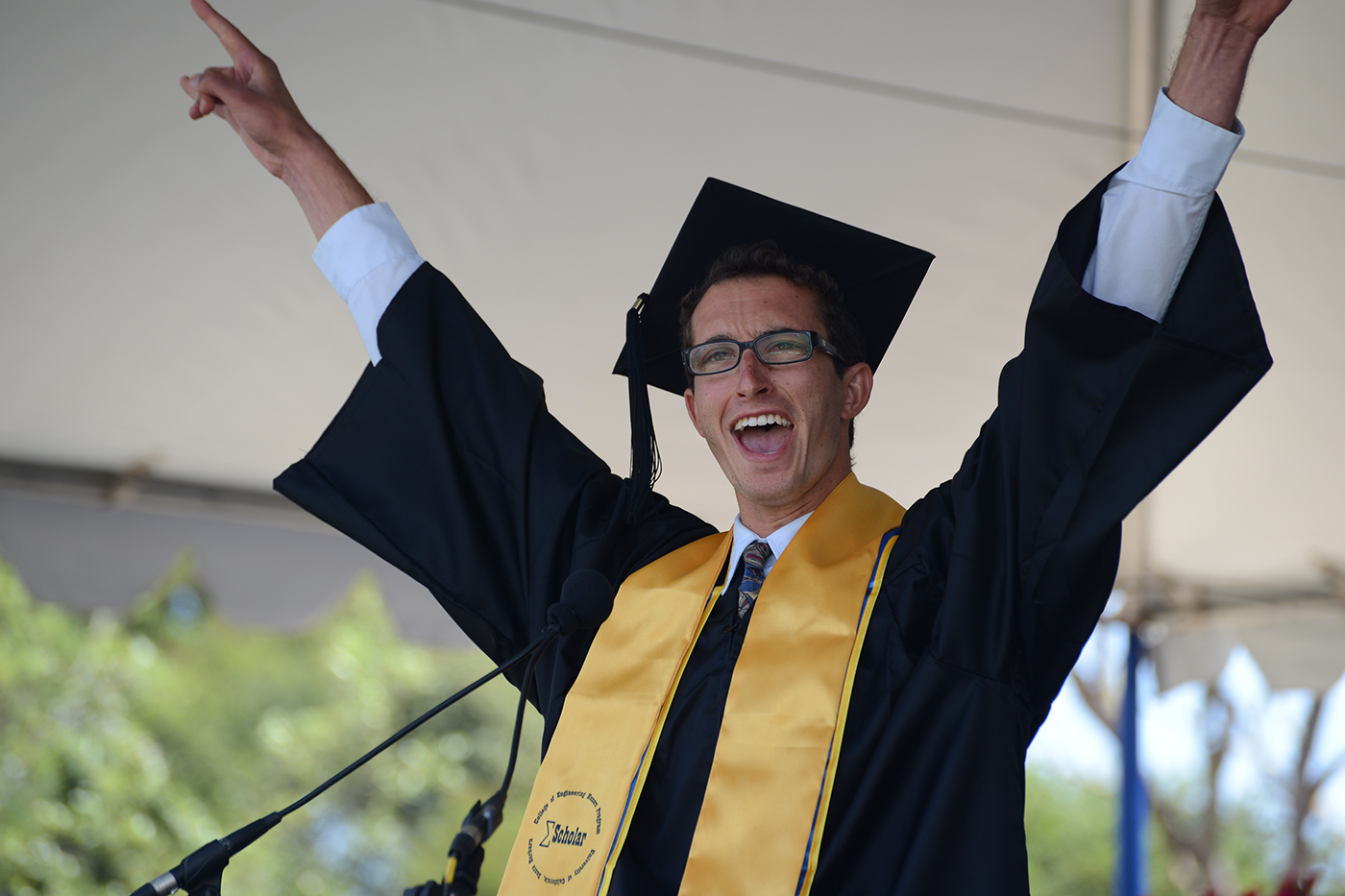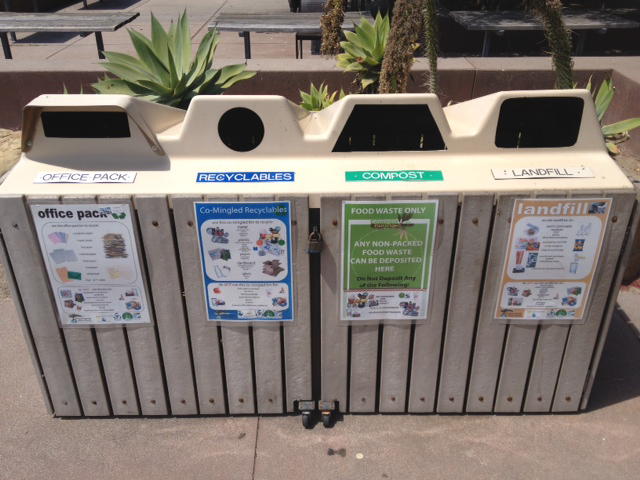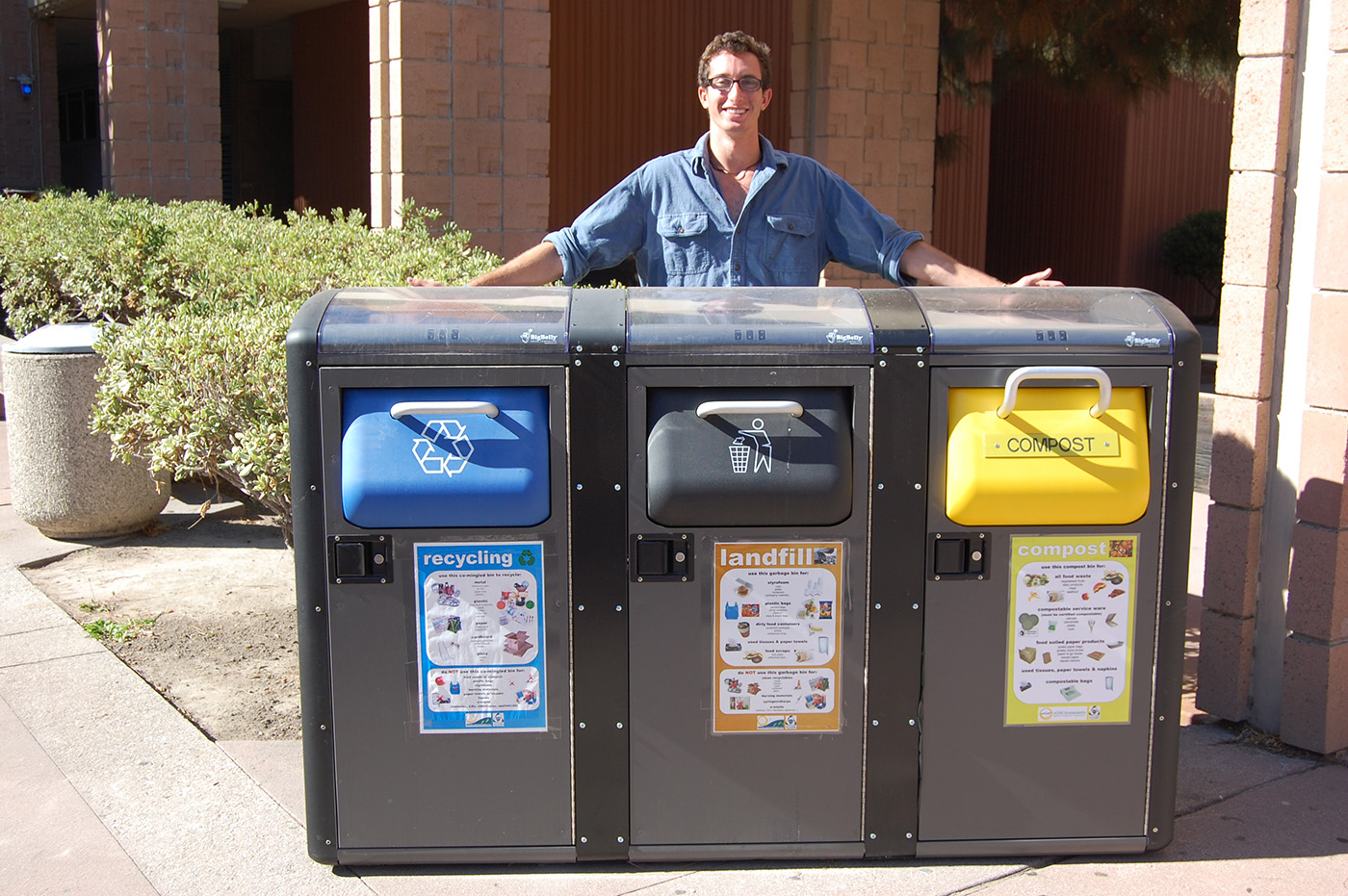In 1993, UCSB generated 3,181.00 tons of total waste; in 2011 it generated 7,612.48 tons of total waste. Issues of waste management led to California’s Integrated Waste Management Act in 1989 which required state entities to divert 25% of waste from landfills by 1995 and 50% by 2000. The University of California adopted similar goals in the Policy on Sustainable Practices to divert 50% of municipal solid waste from landfills by 2008, 75% by 2012, and to generate zero waste by 2020 (source).
Enter Elan Frantz, a UCSB Mechanical Engineering major whose first course assignment as a freshman was to “think of a way to improve something, write about it, and then present on it.” Elan came up with a loose plan to convert UCSB’s ordinary trashcans to garbage-compacting solar-powered robots. These “BigBelly” trashcans, designed and manufactured by BigBelly Inc., use solar power to compact trash to 1/5 of its original volume: “After some research into what we throw away at UCSB, I was astonished by the volumes of waste produced. My project proposed that by using BigBelly trash compactors, we could save time and money, reduce the litter that escapes to the ocean, strengthen our recycling habits, and significantly reduce the carbon emissions of our campus.”
According to its web site, “The BigBelly solar compactor is a patented, compacting trash receptacle that is self-powered by solar energy and software-controlled. The BigBelly waste component takes up as much space as the “footprint” of an ordinary trash can, but its capacity is five times greater. For single-stream recycling, the BigBelly compacting recycler delivers 4:1 compaction, ideal for high-traffic recycling areas. Increased on-site capacity is an important element in collection efficiency. When paired with the power of the real-time fullness status updates, 70-80+% reductions in collection trips and associated operating costs, fuel use, and greenhouse gas emissions are consistently achievable. As waste collects inside a BigBelly solar compactor, an internal “eye” senses when the bin is filling and communicates that information back to the Command Center, generating a command to trigger a compaction cycle, giving collection personnel real-time data on which locations require a collection. Without wasting trips down a street or to a park for locations that do not yet require pick up, crews have the ability to know exactly when BigBelly Solar Compactors are ready for pick up – or still have much more capacity. Safe, easy to use, and designed to keep out pests, the BigBelly components have proven their worth in urban streets, parks, colleges, arenas—in all weather conditions. Designed for reliable performance 24/7/365 in all climates and latitudes, the BigBelly solar compactor is powered by sophisticated and patented software that allows it to run for one week on the equivalent energy of brewing one pot of coffee” (source).
Elan spent the next four years working to raise money to bring the BigBelly to UCSB. His initial grant applications and appeals for private funding were turned down for reasons unknown, but in 2011, after appealing to Tom Beland of Housing and Residential Services, two BigBellies were purchased and placed alongside UCSB dorms. Elan levered the positive performance of these pilot BigBellies to convince Jon Cook of Facilities Management and Marc Fischer, Senior Associate Vice Chancellor for Admin Services, to invest in the project by purchasing eight more BigBellies. These units provided landfill and comingled recycling compactors at the Coral Tree Cafe, the Buchanon Courtyard Cafe, and the Arbor. The Compost Pilot Project, with Phil Jankoski (Residential Services) and Mo Lovegreen (Executive Director, Geography), then added their support to Elan’s proposal to achieve out-of-cycle funding from The Green Initiative Fund to purchase another four BigBelly Compost Compacting units to complement the other clusters already purchased. Matt O’Carroll, a Recycling and Refuse Intern with Physical Facilities, then spearheaded the effort to acquire, install, and maintain these units.
As Elan puts it, “The project has been wildly successful. Instead of taking out the trash at food service stations twice a day, grounds workers are now only servicing them twice a week. This opens up opportunities to give attention to other areas of campus maintenance that are in need. In the old trashcans, if a raccoon was found, animal services was called to euthanize the animal. Now the pests are kept out of the trash permanently and relocate themselves. The amount of loose clutter on campus has been reduced as the trashcans lock the contents in and the amount of recyclable items that accidentally get thrown in the trash has been significantly reduced just based on the appearance of these bins. The ultimate goal is to convert the entire campus to BigBelly. This way, densified trash enters the dumpsters causing them to fill up less often. The garbage trucks then no longer have to drive the 32 miles to the landfill as often, saving potentially hundreds of tons of carbon emissions each year.”
The success of Elan’s project resulted in him being inundated with requests to give presentations on the subject to other undergraduates involved in sustainability, and he was recognized for his efforts by being elected as the 2012 student commencement speaker for the Science and Engineering graduation Ceremony at UCSB (you can watch the video here). Elan also applied his engineering training to finding an improvement to the product, and he currently holds a patent (pending) for an idea that will eliminate odors from the BigBelly system. Since his graduation in June 2012 (BS, Mechanical Engineering), Elan has been employed by the Food Service Technology Center in San Ramon, California, promoting energy efficiency in restaurants, and he continues to work to expand the BigBelly project at UCSB and in his new home in the Bay Area. Good on ‘ya, Elan!








